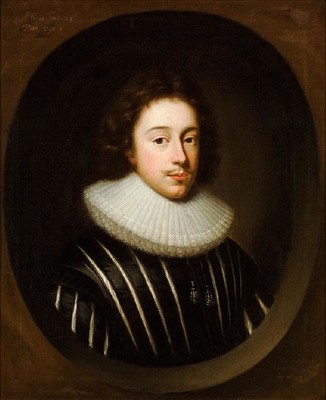B.
A poet in our midst
Behind the scenes
Portrait of an Unknown Man – one of the earliest portraits in the collection – has recently been identified as a portrait of the seventeenth century English poet Edmund Waller (1606–1687).

Unknown Artist, after Cornelius Janssen van Ceulen, Portrait of the poet Edmund Waller, Esq.
Research into the collection's early portraits has been ongoing, but this particular identification came to us on a plate following a Christchurch visit by one of Waller's descendants, who was on holiday from England. Her recognition of the painting's subject was also immediate – the original version of this portrait has been with family since being painted in 1629.
(Our portrait is one of two copies; the other is in the Bodleian Library, Oxford – the family had been unaware of both of these. An engraved version also exists.)
Clues to Waller's identity had been waiting on our canvas, even if darkened by age and varnish layers. Inscriptions beyond the oval frame read, at top left in Latin, 'Ætatis suæ. 23. Vitæ vix. 1' ('Ætatis suæ' indicates a portrait subject's age at the time of being painted). Beneath is the name 'Waller' in black. At lower right of the canvas is the inscription 'The originall [sic] was [?] by CJ in 1629'. 'CJ' was Cornelius Janssen van Ceulen (1593–1661, also known as Cornelius Johnson).
Edmund Waller (1606–1687) was a politician as well as a poet, and is remembered for his ability to adapt to changing political tides. He is however best remembered for his poems (the best known of these is 'Go, Lovely Rose'). In 1629 at 23, Waller was already influential, and is said at that time to have been one of the twelve wealthiest men in England. The inscriptions on the canvas seem to suggest that the copy was made during his lifetime, or possibly in the immediate period following his death. Even as an undated copy, the Gallery's portrait carries much greater interest than has previously been appreciated.
(Work continues on a future exhibition, Telling Likenesses, in which the stories behind some of the earliest portraits in the collection will be told.)
